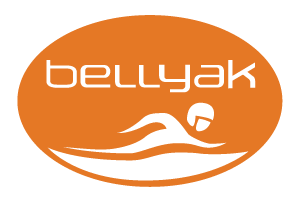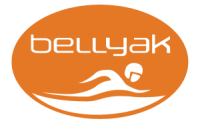Bellyak: the early days
The first bellyaks were my old playboats, cut up and modified. åÊIt all started with a hot pink Perception 3d that I cut up, filled with blue board insulation and spray foam, and covered with vinyl sheeting. åÊAnd about six rolls of Gorilla Tape. åÊMy dad helped me realize the first bellyak, and bought the materials for us to build it together in his shop. åÊThe boat weighed 72 pounds, and leaked like an open window. åÊI paddled this several times down Section 9 of the French Broad River, a class II-III stretch of water close to our home in beautiful Madison County, NC. åÊPaddling this stretch of river, in this boat, proved to me that bellyaking was a good idea, and tons of fun. I’d paddled this section in a kayak before, and kind of found it boring. åÊHowever, in a bellyak, it was a whole new experience. åÊCatching eddies and zipping around in Class II, face first, was exhilirating. åÊIt was as exciting to me as running the åÊGreen River Narrows, without the “i might die doing this” fear. åÊGranted, any new experience soon loses it’s lustre…but I was in a taped up high performance overweight river machine, and was ready to get serious about building better prototypes.
I used the most magical tool of the 21st century, the internet, to research prototyping techniques. åÊI knew I couldn’t keep cutting up playboats, as I would quickly run out of boats, and each boat was a one shot deal. åÊThe first three boats I made were out of a Perception 3d, a Whip It, and a one off prototype I had laying around, the Black Attack (designed by Corran Addison). åÊThe Whip It leaked too much and took on too much water, and the Black Attack didn’t have near enough volume…it would sub out going through drops, separating me from the boat.
I was starting to get an idea of what was needed…playboat hull, volume around the midsection to float higher, and at least seven feet long.
Anyway…I had worked with two part expanding urethane foam to fill the cavities of the Whip It and Black Attack prototypes, and while driving up I26 in Asheville one day I had a moment of inspiration. åÊWhat if I took all the guts out of a kayak, cut it in half, waxed the inside and taped it back together? åÊCould I fill the cavity with A/B foam and create a plug that would release from the “mold?” åÊIn theory, I could shape this plug’s body cavity, and glass over it with fiberglass cloth and epoxy resin…creating a non-leaky prototype. åÊThis would also allow me to get more than one prototype per boat. Luckily, I have excellent family connections who can tell me about these things. åÊI called my uncle, Allen Stancil, long time model maker for Perception and Liquid Logic. åÊHe seemed to think it would work just fine, and my dad confirmed it, telling me about the properties of polyethylene and how it’s a natural mold release (he’s real, real smart about these kind of things).
Anyway, my new friend on the internet became US Composites, supplier of all sorts of foam, fiberglass, resin, etc. åÊI had a broken Perception Phat that was going to be my first victim (naturally, I had to see how a creek boat performed). åÊWe started at my Dad’s shop, cutting the boat in half, and waxing the inside. åÊWe then poured it in stages with the A/B foam, until the cavity was filled. åÊWe let it cure overnight, and I was more excited than a kid on Christmas day to see how it turned out. åÊIt popped right out of it’s mold and I was ready to start shaping! On to phase 2…


